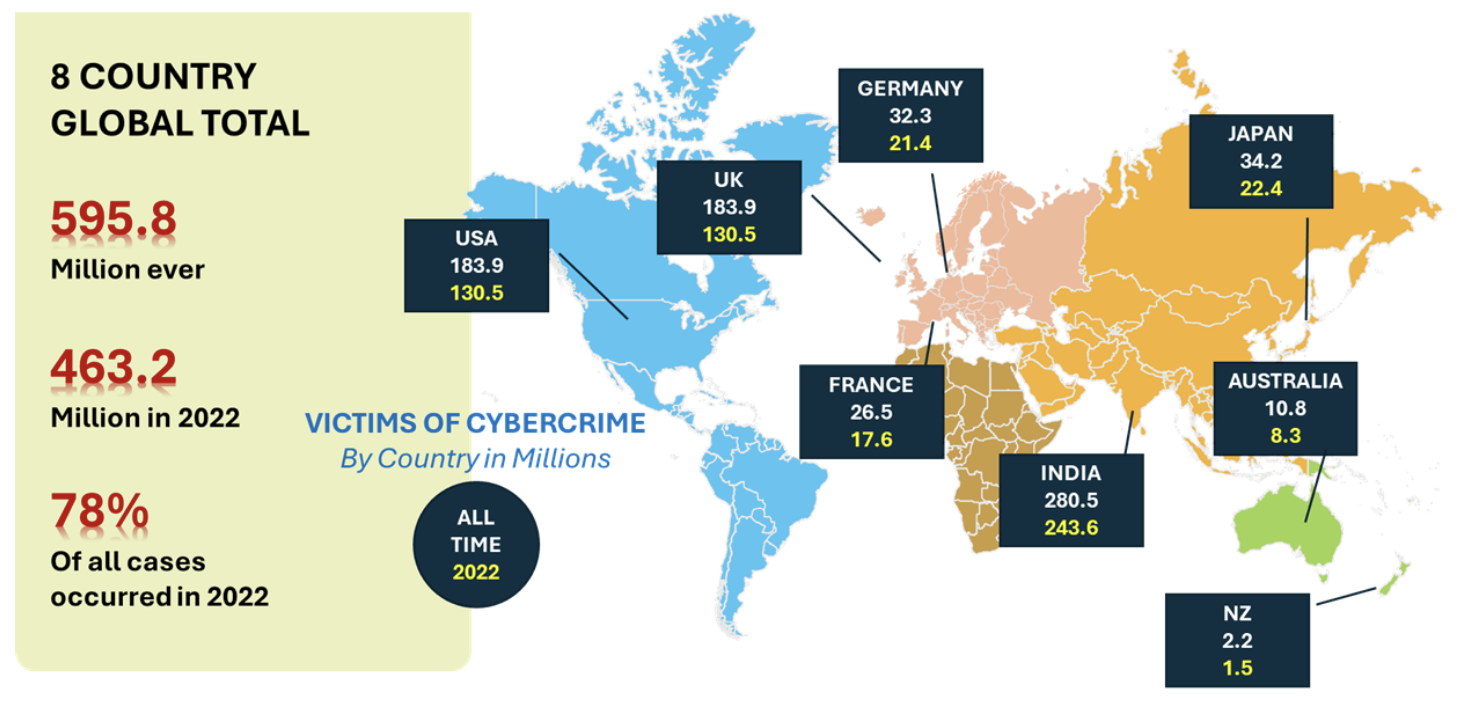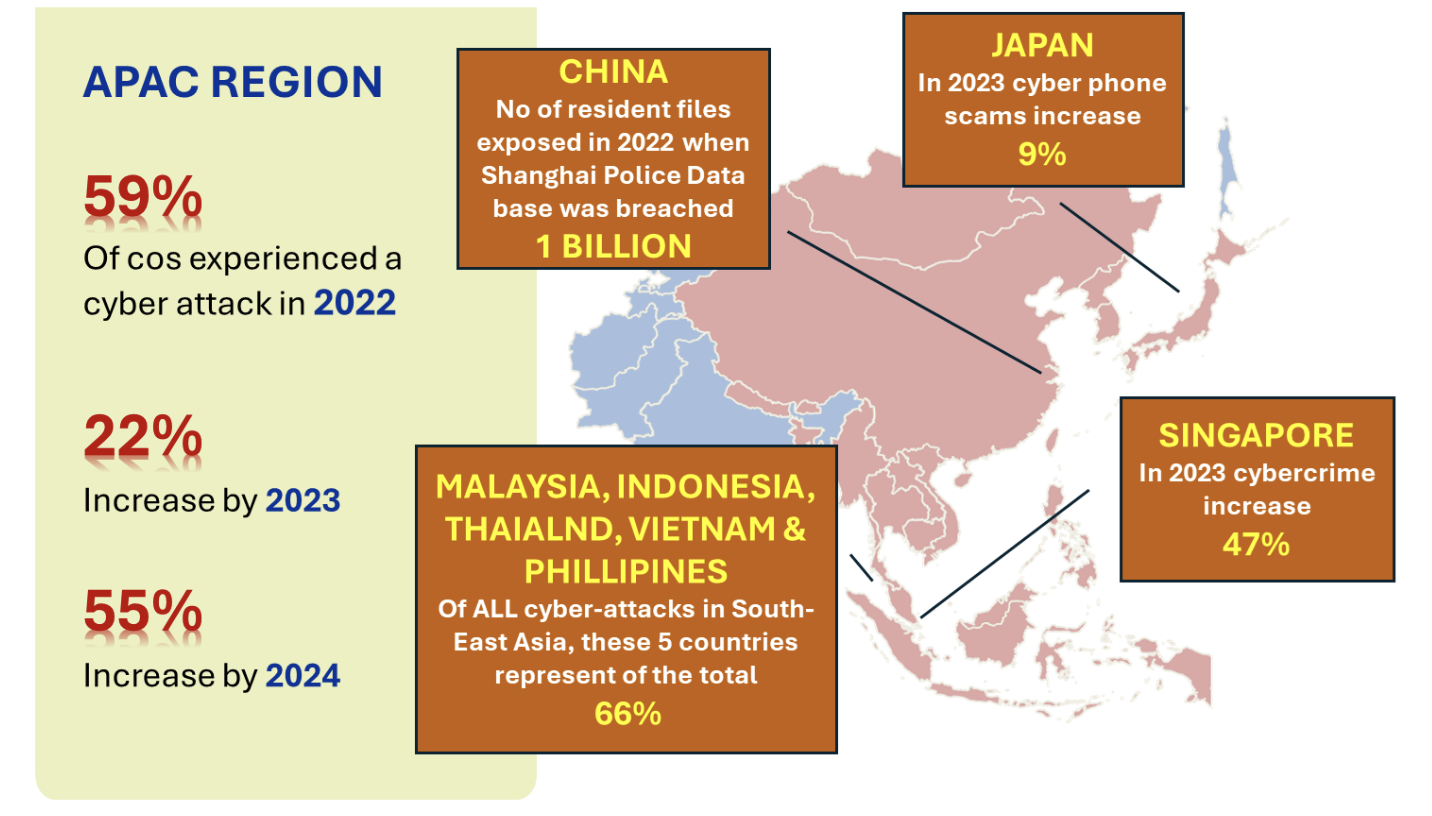
FOR MORE INFORMATION
GLOBAL THREAT OF CYBER ATTACKS CONTINUES TO RISE
Cyberattacks have surged globally, driven by increasing digitalization, political tensions, and sophisticated hacking tools. Critical sectors like finance, healthcare, and government face growing threats, including predatory behaviour, financial scams, ransomware, phishing, and data breaches.
By the end of 2022, 78% of ALL cyber attacks and breaches occurred in that year,
In 2023 alone, global cybercrime damages exceeded $8 trillion.
As remote work and cloud reliance expand, so does vulnerability—making cybersecurity a top priority for nations, businesses, schools and parents worldwide.
LATEST NEWS: (22 May 2025) Retail Giant Marks & Spencer to take 2 months to recover from a cyber-attack. M&S confirmed that customer data had been stolen, although it said no passwords or card details were accessed. The company advises that operating profits will be reduced by around £300 million due to the impact of the attack. M&S is just one of many major retailers that have been hacked recently.
M&S to face disruption from massive cyber attack for another two months | News Tech | Metro News
ASIA IS NOT IMMUNE TO THIS GLOBAL THREAT
Asia faces rising cyber threats due for all the same reasons, as well as an uneven cybersecurity infrastructure across the region.
Key risks include the targeting of vulnerable groups like children, teenagers and the elderly, through financial scams, bullying and threats of sextortion which can often lead to financial ruin and even suicide.
Nations like Malaysia, Indonesia, India and Japan have reported surging attack rates, while regional tensions have fuelled state-sponsored hacking.
THE REAL IMPACT OF CYBERBULLYING ACROSS ASIA
There is growing evidence across Asia showing a clear and troubling link between cyberbullying and teenage suicide:
MALAYSIA
A study of 1,290 Malaysian teenagers aged 13–17 revealed 13.7% had been cyberbullied, while 17.1% showed suicidal behavior (including thoughts, plans, or attempts). The study confirmed cyberbullying as a significant risk factor even after accounting for other variables .
Another Malaysian survey highlighted the role of psychological distress—like anxiety and depression—in mediating the path from cyberbullying to suicidal thoughts.
Tragic real-life incidents include a 16-year-old who ended her life after an Instagram poll, and a 20-year-old in Penang who committed suicide following viral cyberharassment. en.wikipedia.org+3pmc.ncbi.nlm.nih.gov+3reddit.com+3.
HONG KONG
A 2016 study with 3,522 adolescents found that 11.9% experienced cyberbullying, and 21.8% had suicidal thoughts that year. Victims were 2.5 times more likely to have suicidal ideation than those not bullied en.wikipedia.org+15pubmed.ncbi.nlm.nih.gov+15scmp.com+15.
VIETNAM
Data from Hue City (2018–2021) showed cyberbullying—whether as a victim, bully, or both—dramatically increases the odds of suicidal ideation, planning, or attempts among middle and high schoolers cyberbullying.org+7bmcpublichealth.biomedcentral.com+7pubmed.ncbi.nlm.nih.gov+7.
CROSS-NATIONAL FINDINGS
A survey of nearly 10,000 teens (ages 13–15) across Singapore, China, Iran, Indonesia, India, and Lithuania found that 5.4% were victims of cyberbullying, with 4.8% attempting suicide. The highest risk was among those who faced both traditional and online bullying pubmed.ncbi.nlm.nih.gov.
KEY TAKEAWAYS
Teens who suffer cyberbullying are 2–3 times more likely to experience suicidal thoughts or behaviours.
Psychological distress—such as anxiety, depression, and emotional exhaustion—often mediates this relationship, worsening mental health outcomes en.wikipedia.org+15sciencedirect.com+15bmcpublichealth.biomedcentral.com+15.
Numerous tragic real-world cases across Asia highlight the lethal consequences of online harassment.
Cyberbullying in Asia is not just an online scourge—it has tangible, devastating effects on young people's mental health. With confirmed statistical links between cyberbullying and teenage suicide, there’s a pressing need for stronger prevention programs, digital education, and emotional support systems to protect vulnerable youth.
CASE STUDIES
Elijah “Eli” H. - 16y.o. Kentucky USA
Meet Eli H., a typical happy go lucky 16-year-old high student from Kentucky in the USA. He played tennis and told “dad jokes”. By all account he was happy and well liked by his peers and friends.
But all that changed on 28 February in the space of 1 hour. He became the target of online predators in an alleged sextortion scheme.
What is sextortion? This where the predator uses photos copied from social media sites to create AI-generated, sexually explicit photos of the victim and threatens to release them if a sum of money is not paid within a deadline.
Eli was the victim of such a scam, and the predator demanded $3,000 not to release these fake photos. To Eli there was no way out other than to take his own life.
David G. Jnr – 15y.o. Utah USA
In January this year David G. was by what appeared to be a teenage girl.
Once the predator had his number, they told David they knew where he lived and threatened to release a sexually explicit photos to his family and friends
The predator demanded $200. David didn’t have access to the money, so he took his own life. This all occurred over 5hr period.
Jack S. - 20y.o. Pennsylvania USA
When Jack S. took his own life in January 2023, his parents were left wondering what went wrong. Jack had good friends, seemed happy and was enjoying college and life.
It was soon determined that Jack was the target of a sextortion scam. Dad learned that Jack had paid the predator $3,200 over the course of 15 hours, in $100, $200 and $500 increments. “They keep pushing until they get it all, they break them”
WHAT DO I DO NEXT?
A simple, obligation free discussion with our consultant to establish your needs and what we can design for your school is all.
Contact us on info@piedmontasia.com or call +65 9712 5855 and speak to John Ntatsopoulos to make an appointment.







